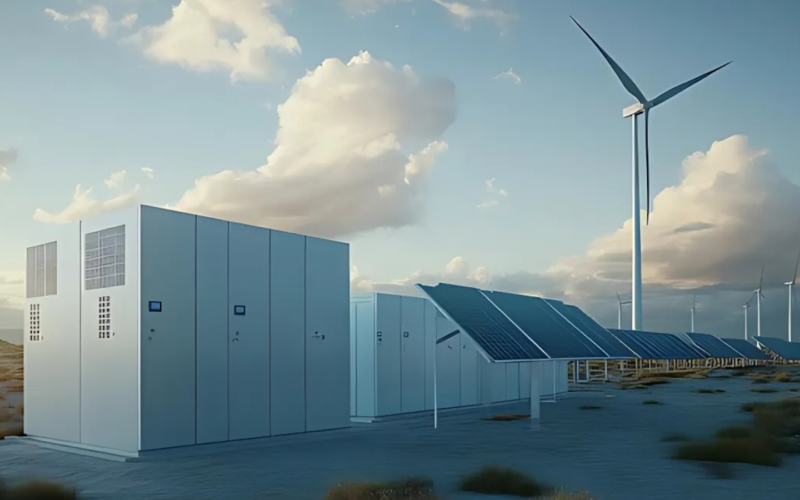Energy storage is essential for a sustainable future, but integrating renewable energy sources into the grid remains a major hurdle. Take, for example, the U.S. AI-driven battery technology market, valued at $3.5 billion in 2024 and expected to grow fivefold to $19.4 billion by 2034. This surge highlights the potential AI holds in transforming energy storage.
For many businesses and homes, the challenge lies in managing fluctuating energy supplies efficiently and reducing costs. AI in energy storage can help solve these issues by optimizing how and when energy is stored and used.
In this article, you’ll learn how AI is revolutionizing energy storage systems, improving efficiency, and helping to balance supply with demand.
In a Nutshell:
- Why Energy Storage Matters: Energy storage ensures reliable grid performance by storing excess renewable energy and releasing it when demand spikes.
- AI Technologies in Energy Storage: AI optimizes storage with machine learning, predictive maintenance, and real-time forecasting to improve efficiency and reduce costs.
- Future Trends in AI and Energy Storage: Trends like hybrid storage systems, autonomous microgrids, and quantum-inspired optimization are making energy storage smarter and more adaptable.
- Codewave’s Role: Codewave creates AI-driven solutions that enhance energy storage, helping businesses reduce costs and stay ahead in the future of energy management.
Why Energy Storage Matters?
Energy storage plays a crucial role in managing clean energy, but it’s often tricky to get it right. With fluctuating renewable sources like wind and solar, AI in energy storage steps in to make things more efficient.
To understand the importance of AI in energy storage, let’s first look at why energy storage itself is so crucial for modern power grids:
- Renewable Energy Integration: Solar and wind power are variable, meaning energy isn’t always available when it’s needed. Storage ensures that excess energy can be stored and used during low-production periods.
- Grid Stability: Energy storage systems help balance the supply and demand, smoothing out fluctuations in energy generation. This keeps the grid stable, reduces the risk of blackouts, and ensures a reliable power supply.
- Energy Security: Stored energy serves as a backup, ready to be used in case of emergencies, power shortages, or grid failures, helping to avoid disruptions.
- Peak Load Management: Energy storage can be used to meet peak energy demands, reducing the strain on the grid during high-use periods, such as hot summer afternoons or during major events.
- Cost Reduction: By storing energy during off-peak hours when electricity is cheaper, storage systems can release it during high-demand times, helping to lower overall energy costs.
- Grid Flexibility and Decentralization: With decentralized storage solutions, local energy production can be stored and used efficiently without relying on central power plants, making the grid more flexible and less vulnerable to large-scale failures.
- Environmental Impact: By enabling greater use of renewable energy, energy storage helps reduce reliance on fossil fuels, contributing to a more sustainable and eco-friendly energy system.
Struggling to implement AI in energy storage? Explore Codewave’s AI/ML Development services to optimize your energy systems, reduce costs, and enhance efficiency. Start using AI to transform your energy storage operations today!
With energy storage so crucial, AI steps in to tackle its toughest challenges. Here’s how the technology is reshaping storage systems.
AI Technologies in Energy Storage
According to IDC, by 2026, half of advanced-market utilities will use AI-powered systems to coordinate distributed energy sources, aiming to cut carbon emissions by up to 30%. That’s a clear sign the industry isn’t just collecting data, it’s starting to act on it.
Let’s look at the AI technologies that turn storage into a responsive, data-driven network.
Machine learning algorithms analyze historical and real-time energy data to identify patterns in consumption, generation, and storage. For instance, ML can predict when solar panels will generate excess energy and schedule storage accordingly.
This reduces wasted energy, ensures supply during peak demand, and helps grid operators plan more effectively.
2. Predictive Maintenance
AI monitors the condition of batteries and storage components continuously. Sensors track temperature, voltage, and performance metrics, allowing the system to predict failures before they happen.
This prevents costly downtime and extends the lifespan of storage assets, ensuring reliability in critical grid operations.
3. Reinforcement Learning
Reinforcement learning trains storage systems to make decisions by learning from outcomes. For example, an AI model can test different charging and discharging strategies in real time, learning which approach maximizes efficiency and minimizes wear on batteries.
Over time, the system optimizes itself for changing demand and supply conditions.
4. Forecasting Algorithms
Advanced forecasting tools use weather data, consumption trends, and historical output to predict both short-term and long-term energy availability. This is especially useful for renewable-heavy grids, where wind and solar production fluctuate.
Accurate forecasts allow storage systems to prepare for peaks, avoid shortages, and reduce reliance on backup fossil fuel generators.
5. Optimization Algorithms
Optimization algorithms calculate the best way to manage energy flow across multiple storage units, balancing efficiency, cost, and longevity. For example, they decide which battery to charge first, how much energy to release during peak hours, and when to draw from the grid. This ensures maximum utility from each storage asset.
Struggling to manage energy storage inefficiencies and complex data? Explore Codewave’s Generative AI Development services to build smart, purpose-driven tools that optimize your energy operations. Start turning your data into action today!
With the key AI technologies in place, the next question is where this combination of intelligence and storage is headed.
Future Trends in AI and Energy Storage
AI is driving the next phase of energy storage. Smarter grids, adaptive systems, and advanced strategies are pushing efficiency, reliability, and scalability to new levels, shaping how we generate, store, and use energy.
Here are the key trends showing where AI in energy storage is headed next.
AI-Driven Hybrid Storage Systems
Hybrid storage systems combine multiple types of energy storage, batteries, supercapacitors, and thermal units into a single setup. Each type handles energy differently: batteries store large amounts for long-term use, supercapacitors deliver short, high-power bursts, and thermal units manage heat energy.
Role of AI: AI manages which storage type to use at any moment, balancing efficiency, lifespan, and energy demand. It predicts load, schedules charge/discharge cycles, and ensures smooth integration with the grid.
Benefits & Challenges:
| Benefits | Challenges |
| Efficient energy use across different storage types | Complex system coordination |
| Extended lifespan of components | Higher upfront cost |
| Improved grid stability and response | Requires accurate real-time data |
Example Use Case:
A solar + wind farm uses AI to dynamically route excess energy: supercapacitors handle sudden surges, batteries store long-term excess, and thermal units absorb heat from solar panels, keeping the system stable and efficient.
Autonomous Microgrid Coordination
Autonomous microgrids are localized energy networks that can operate independently or alongside the main grid. Multiple storage units, batteries, flywheels, or other systems work together to supply energy locally, adjusting automatically to demand and supply fluctuations.
Role of AI: AI coordinates the microgrid in real time, predicting local energy demand, balancing loads between storage units, and deciding when to draw or supply power to the main grid. This ensures the microgrid operates efficiently without constant human oversight.
Benefits & Challenges:
| Benefits | Challenges |
| Increased resilience during outages | High setup and management complexity |
| Optimized local energy use | Requires reliable, continuous data streams |
| Faster response to demand spikes | Integration with main grid can be tricky |
Example Use Case:
A remote community with solar panels and battery banks uses AI-managed microgrids to ensure power continuity. The system distributes energy intelligently between households, handles sudden demand surges, and can operate independently if the main grid goes down.
Adaptive Energy Arbitrage
Energy arbitrage involves storing electricity when prices are low and selling or using it when prices are high. Adaptive energy arbitrage uses AI to make these decisions dynamically, responding to real-time grid conditions, market prices, and demand patterns.
Role of AI: AI predicts electricity price fluctuations and demand trends, automatically deciding when to charge storage units and when to discharge. This optimizes both economic returns and grid efficiency without constant human intervention.
Benefits & Challenges:
| Benefits | Challenges |
| Maximizes revenue from stored energy | Requires accurate, high-frequency market and consumption data |
| Improves grid efficiency by balancing supply | Complex predictive algorithms needed |
| Reduces wasted energy during low-demand periods | Potential regulatory or market constraints |
Example Use Case:
A utility company with large battery storage monitors wholesale electricity prices in real time. AI charges the batteries when solar output exceeds demand and prices drop, then sells energy back to the grid during peak hours for maximum profit.
AI-Powered Second-Life Battery Management
Second-life battery management repurposes used electric vehicle (EV) batteries for grid or local energy storage. While these batteries may no longer meet EV performance standards, they still retain significant capacity for stationary applications.
Role of AI: AI monitors battery health, predicts degradation patterns, and manages charge/discharge cycles to maximize performance and lifespan. It ensures these recycled batteries operate safely and efficiently within storage systems.
Benefits & Challenges:
| Benefits | Challenges |
| Cost-effective energy storage solution | Variability in battery condition |
| Reduces electronic waste and supports sustainability | Complex monitoring and management required |
| Extends usable life of EV batteries | Safety and performance consistency must be ensured |
Example Use Case:
A city converts retired EV batteries into neighborhood storage hubs. AI continuously tracks each battery’s condition, directs energy where needed, and schedules charging and discharging to provide reliable, sustainable local energy.
Quantum-Inspired Optimization for Storage
Quantum-inspired optimization uses AI algorithms modeled on quantum computing principles to handle complex energy storage challenges. This approach solves large-scale scheduling, distribution, and load-balancing problems that classical methods struggle with.
Role of AI: AI uses these quantum-inspired algorithms to optimize energy flow across multiple storage units, forecast demand, and balance supply in real time. It makes rapid, high-accuracy decisions for large or distributed storage networks.
Benefits & Challenges:
| Benefits | Challenges |
| Faster, smarter decision-making across large networks | High computational requirements |
| Optimizes energy allocation for efficiency and cost | Requires specialized expertise to implement |
| Improves reliability and scalability of storage systems | Integration with existing infrastructure can be complex |
Example Use Case:
A national grid uses AI with quantum-inspired optimization to manage thousands of battery and thermal storage units. The system dynamically allocates energy across regions, reduces bottlenecks, and ensures efficient delivery even during peak demand.
Discover the powerful potential of AI in solar energy and how its innovative applications are transforming energy efficiency, grid management, and sustainable energy solutions.
AI is changing how we store and use energy, making systems smarter, more efficient, and future-ready. Knowing these trends helps you stay ahead as energy solutions evolve.
Why Choose Codewave for AI in Energy Storage Solutions?
When you’re looking to make energy storage smarter, you need more than just batteries or software. At Codewave, we help you build AI-driven solutions that tackle real challenges in energy management. By combining advanced technology with our expertise, we turn concepts into practical, efficient systems that boost reliability, reduce costs, and make energy more flexible.
Curious to see how Codewave’s AI-driven energy storage solutions can make a real difference? Explore our portfolio to see how we’ve helped businesses turn smart energy ideas into efficient, reliable power systems.
What you get with Codewave’s AI solutions for energy storage:
- 60% faster deployment of AI-powered tools for battery management, grid balancing, and predictive energy optimization.
- 3x quicker pilot-to-production cycle, letting you implement AI applications like adaptive energy arbitrage or hybrid storage coordination with minimal delays.
- Save up to 3 weeks each month by automating monitoring, forecasting, and load-balancing tasks across storage systems.
- 25% lower development costs through AI-driven workflows that integrate seamlessly with your existing energy infrastructure.
Our AI solutions for energy storage:
- AI Integration for Energy Systems: We assess your needs and create custom AI use cases for energy optimization, predictive maintenance, and more.
- Custom AI Tool Development: From idea to deployment, we build tools like energy forecasting systems, grid balancing algorithms, and battery health monitors to enhance storage efficiency.
- Advanced AI Feature Integration: We embed AI into your existing energy platforms for real-time insights, smart load balancing, and dynamic energy management across storage systems.
- Operational Analytics & Optimization: We offer AI-powered dashboards and reporting tools to track energy performance, reduce inefficiencies, and make data-driven decisions for optimal storage use.
Curious to see how AI can transform your energy storage operations? Book a session with Codewave’s experts and explore how we can turn your energy data into efficient, actionable solutions.
FAQs
Q. How does AI improve the efficiency of hybrid energy storage systems?
A. AI in energy storage significantly improves hybrid systems by determining the optimal use of multiple storage types, such as batteries, supercapacitors, and thermal storage. By predicting energy demand and supply fluctuations, AI decides which energy source to use at any given time, maximizing efficiency and prolonging the lifespan of storage assets.
Q. How does AI handle fluctuating energy sources like solar and wind in storage systems?
A. AI in energy storage excels at managing the intermittent nature of renewable energy sources like solar and wind. It uses predictive algorithms to forecast periods of high energy production, storing excess power during those times, and then releasing it when generation drops. This dynamic approach allows for more reliable energy availability, smoothing out the fluctuations from renewable sources and making the grid more stable.
Q. How secure is the data used by AI in energy storage systems?
A. Data security is a crucial aspect of AI in energy storage. AI systems rely on large amounts of data to optimize performance, and protecting this data is essential. Advanced encryption protocols and secure cloud storage are typically used to ensure that sensitive data, such as energy usage patterns and system performance metrics, is kept safe from cyber threats.
Q. How can small businesses benefit from AI in energy storage solutions?
A. Small businesses can benefit from AI in energy storage by improving their energy management efficiency and reducing operational costs. AI tools can help predict energy consumption patterns, manage energy use during peak times, and store energy more efficiently. For businesses that rely heavily on energy, such as those in manufacturing or retail, AI-driven storage solutions can lower energy bills, reduce waste, and even generate extra income by participating in energy markets.
Q. What does the future hold for AI in energy storage?
A. The future of AI in energy storage looks promising, with innovations focused on increasing efficiency, scalability, and integration with renewable energy sources. We can expect AI systems to become more autonomous, predicting and managing energy storage on a global scale. With advancements like quantum-inspired optimization and more accurate forecasting, AI will continue to improve energy resilience, reduce costs, and enable smarter grid management.
Codewave is a UX first design thinking & digital transformation services company, designing & engineering innovative mobile apps, cloud, & edge solutions.







